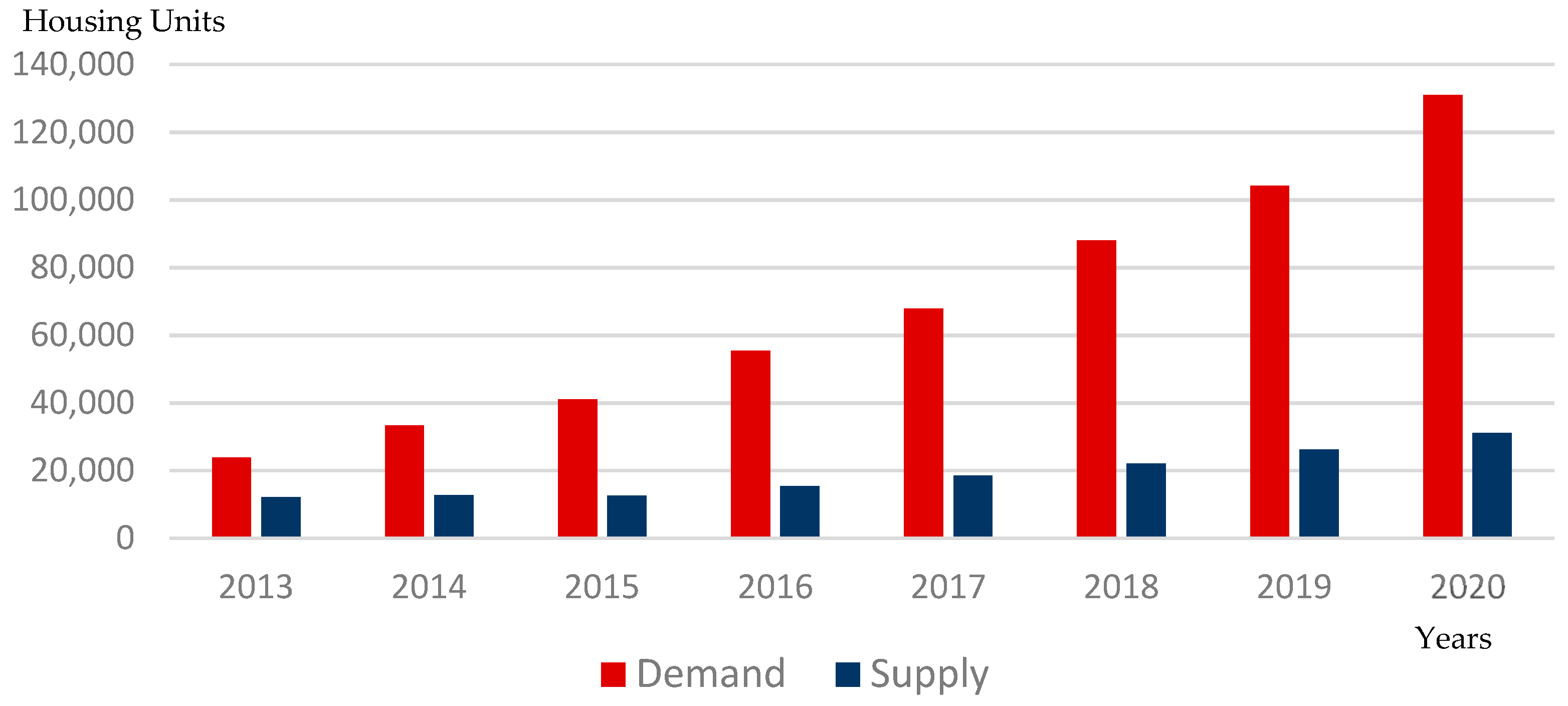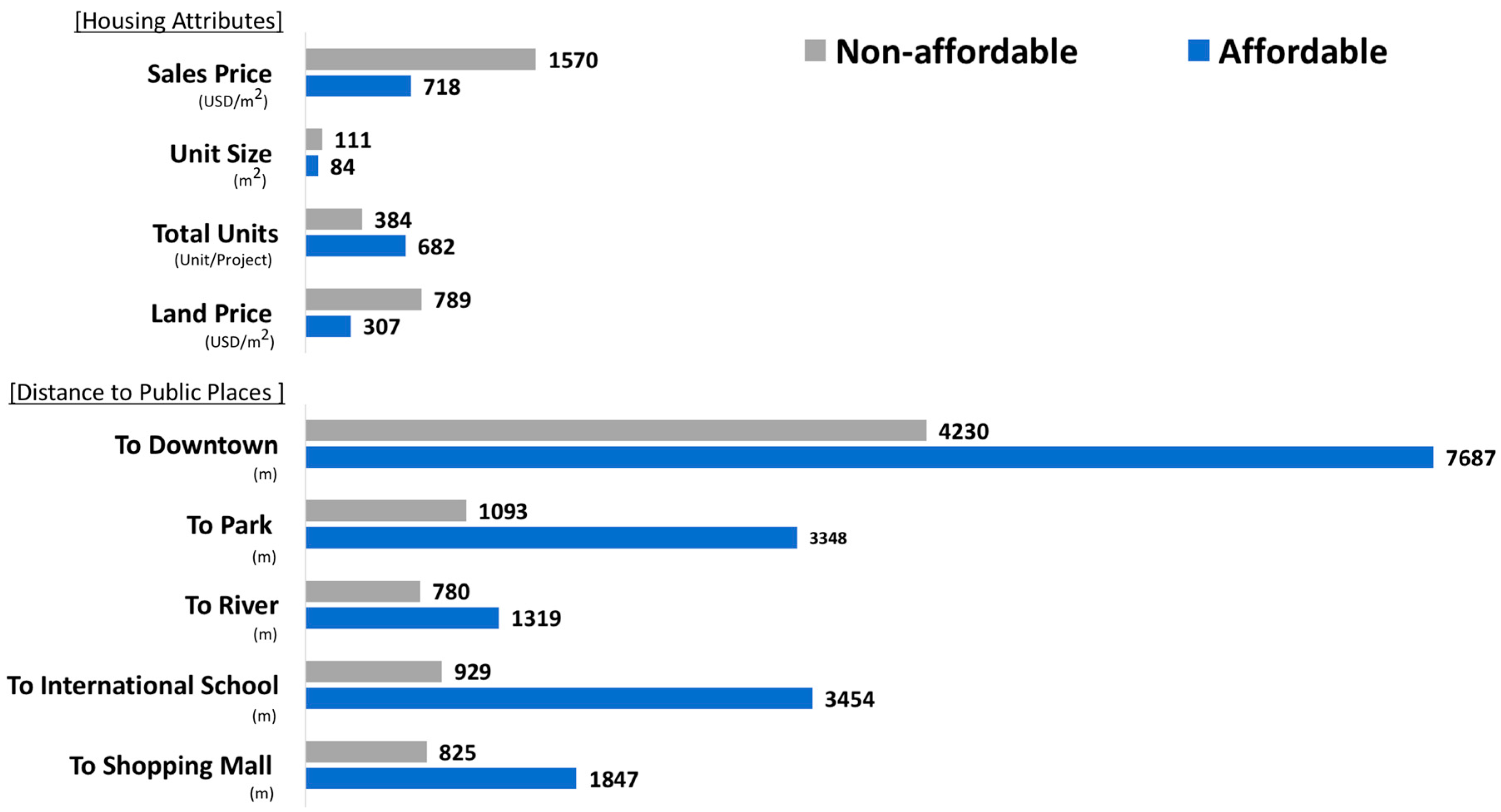Price Determinants of Affordable Apartments in Vietnam: Toward the Public–Private Partnerships for Sustainable Housing Development
Abstract
1. Introduction
1.1. Economic Growth and Housing Development in Vietnam
1.2. Affordable Housing in Vietnam
1.3. Study Purpose and Framework
2. Literature Review
2.1. Hedonic Price Model
2.2. Studies of Apartments for Price Determinants in Vietnam
3. Methods
3.1. Data Collection
3.2. Identification of the Price Range for Affordable Housing in Vietnam
3.3. Variables for Hedonic Regression Model
- p denotes the per-unit sales price of property;
- ε is a random error term vector;
- βk (k = 1, …, K) indicates the coefficient matrix of independent variables x and shows the rate of price change with the characteristics x.
4. Results and Findings
4.1. Descriptive Statistics
4.2. Regression Results
5. Discussion
5.1. Common Price Determinants for Both Affordable and Unaffordable Segments
5.2. Unique Price Determinants for Affordable Apartments
5.3. Unique Determinants of Price for Unaffordable Apartments
6. Conclusions
Acknowledgments
Author Contributions
Conflicts of Interest
References
- Beresford, M. Doi Moi in review: The challenges of building market socialism in Vietnam. J. Contemp. Asia 2008, 38, 221–243. [Google Scholar] [CrossRef]
- UN_Habitat. Vietnam Housing Sector Profile; UN Habitat: Nairobi, Kenya, 2014; p. 158. [Google Scholar]
- Vietnam_Property. Vietnam Real Estate Attracts a Large Amount of Foreign Direct Investment. Available online: https://www.vietpropertynews.com/2017/07/03/vietnam-real-estate-investment/ (accessed on 11 November 2017).
- Bang, L. Middle-Class Vietnamese: Who Are They? Available online: http://english.vietnamnet.vn/fms/business/160959/middle-class-vietnamese--who-are-they-.html (accessed on 11 July 2017).
- CBRE. Vietnam Real Estate Market Insights. 2016. Available online: http://www.cbrevietnam.com/ (accessed on 19 July 2017).
- Seo, D.; Kwon, Y. In-migration and housing choice in Ho Chi Minh City: Toward sustainable housing development in Vietnam. Sustainability 2017, 9, 1738. [Google Scholar] [CrossRef]
- Truitt, A. On the back of a motorbike: Middle-class mobility in Ho Chi Minh City, Vietnam. Am. Ethnol. 2008, 35, 3–19. [Google Scholar] [CrossRef]
- Thanh-Nien-News. Ho Chi Minh City Now Has 7.4 Million Motorbikes, and Counting. Available online: http://www.thanhniennews.com/society/ho-chi-minh-city-now-has-74-million-motorbikes-and-counting-57787.html (accessed on 22 September 2017).
- Chung, Y.S.; Kim, J.H.; Cho, J.H. Analysis of price determinants of apartments in ho chi minh. J. Korean Hous. Assoc. 2014, 12, 13–21. [Google Scholar]
- Woetzel, J.; Ram, S.; Mischke, J.; Garemo, N.; Sankhe, S. A Blueprint for Addressing the Global Affordable Housing Challenge; McKinsey Global Institute: New York, NY, USA, 2014. [Google Scholar]
- World_Bank_Group. Vietnam Affordable Housing: A Way Forward; World Bank Group: Washington, DC, USA, 2015; p. 117. [Google Scholar]
- JLL. Ho Chi Minh City Trip Report: The Opportunity Lies in Building Homes. Available online: http://www.ap.jll.com/asia-pacific/en-gb/research/798/hcmc-citytripreport-aug2016#.WlloP1JOb_8 (accessed on 12 November 2017).
- EZLand. Affordable Housing Market Overviews. Available online: https://www.vietnambusiness.tv/docs//vre/20160201 EZLand Presentation_Market Overviews.pdf (accessed on 1 November 2017).
- Court, A.T. Hedonic price indexes with automotive examples. In The Dynamics of Automobile Demand; General Motors Corporation: Detroit, MI, USA, 1939. [Google Scholar]
- Lancaster, K.J. A new approach to consumer theory. J. Political Economy 1966, 74, 132–157. [Google Scholar] [CrossRef]
- Rosen, S. Hedonic prices and implicit markets: Product differentiation in pure competition. J. Political Economy 1974, 82, 34–55. [Google Scholar] [CrossRef]
- Xiao, Y.; Webster, C. Urban Morphology and Housing Market; Springer: Berlin, Germany, 2017. [Google Scholar]
- Sirmans, G.S.; MacDonald, L.; Macpherson, D.A.; Zietz, E.N. The value of housing characteristics: A meta analysis. J. Real Estate Financ. Econ. 2006, 33, 215–240. [Google Scholar] [CrossRef]
- Kain, J.F.; Quigley, J.M. Measuring the value of housing quality. J. Am. Stat. Assoc. 1970, 65, 532–548. [Google Scholar] [CrossRef]
- Kohlhase, J.E. The impact of toxic waste sites on housing values. J. Urban Econ. 1991, 30, 1–26. [Google Scholar] [CrossRef]
- Kilpatrick, J.A.; Hefner, F. House Price Impact of School District Choice; South Carolina Center for Applied Real Estate Education and Research: Seattle, WA, USA, 1998. [Google Scholar]
- Gibbons, S.; Machin, S. Valuing English primary schools. J. Urban Econ. 2003, 53, 197–219. [Google Scholar] [CrossRef]
- Visser, P.; Van Dam, F.; Hooimeijer, P. Residential environment and spatial variation in house prices in the netherlands. Tijdschr. Econ. Soc. Geogr. 2008, 99, 348–360. [Google Scholar] [CrossRef]
- Baumont, C.; Legros, D. Neighborhood Effects in Spatial Housing Value Models. The Case of the Metropolitan Area of Paris (1999); Federal Reserve Bank of St Louis: St. Louis, MO, USA, 2009. [Google Scholar]
- Anderson, R.J., Jr.; Crocker, T.D. Air pollution and residential property values. Urban Stud. 1971, 8, 171–180. [Google Scholar] [CrossRef]
- Wilman, E.A.; Krutilla, J. Hedonic prices and beach recreational values. Adv. Appl. Microecon. 1981, 1, 98. [Google Scholar]
- Murdoch, J.C.; Thayer, M.A. Hedonic price estimation of variable urban air quality. J. Environ. Econ. Manag. 1988, 15, 143–146. [Google Scholar] [CrossRef]
- Day, B.; Bateman, I.; Lake, I. Beyond implicit prices: Recovering theoretically consistent and transferable values for noise avoidance from a hedonic property price model. Environ. Resour. Econ. 2007, 37, 211–232. [Google Scholar] [CrossRef]
- Bateman, I.; Day, B.; Lake, I.; Lovett, A. The Effect of Road Traffic on Residential Property Values: A Literature Review and Hedonic Pricing Study; Scottish Executive: Edinburgh, UK, 2001; Volume 207. [Google Scholar]
- Schipper, Y.; Nijkamp, P.; Rietveld, P. Why do aircraft noise value estimates differ? A meta-analysis. J. Air Transp. Manag. 1998, 4, 117–124. [Google Scholar] [CrossRef]
- Nelson, J.P. Highway noise and property values: A survey of recent evidence. J. Transp. Econ. Policy 1982, 16, 117–138. [Google Scholar]
- Graves, P.; Murdoch, J.C.; Thayer, M.A.; Waldman, D. The robustness of hedonic price estimation: Urban air quality. Land Econ. 1988, 64, 220–233. [Google Scholar] [CrossRef]
- Smith, V.K.; Huang, J.-C. Can markets value air quality? A meta-analysis of hedonic property value models. J. Political Econ. 1995, 103, 209–227. [Google Scholar] [CrossRef]
- Steinnes, D.N. Measuring the economic value of water quality. Ann. Reg. Sci. 1992, 26, 171–176. [Google Scholar] [CrossRef]
- Michael, H.J.; Boyle, K.J.; Bouchard, R. Water Quality Affects Property Prices: A Case Study of Selected Maine Lakes; Maine Agricultural and Forest Experiment Station Report Number 398; University of Maine: Orono, ME, USA, 1996. [Google Scholar]
- Nowak, D.J.; McPherson, E.G. Quantifying the impact of trees: The Chicago urban forest climate project. Unasylva 1993, 173, 39–44. [Google Scholar]
- Tyrväinen, L. The amenity value of the urban forest: An application of the hedonic pricing method. Lands. Urban Plan. 1997, 37, 211–222. [Google Scholar] [CrossRef]
- Lutzenhiser, M.; Netusil, N.R. The effect of open spaces on a home’s sale price. Contemp. Econ. Policy 2001, 19, 291–298. [Google Scholar] [CrossRef]
- Anderson, S.T.; West, S.E. Open space, residential property values, and spatial context. Reg. Sci. Urban Econ. 2006, 36, 773–789. [Google Scholar] [CrossRef]
- Landau, U.; Prashker, J.N.; Hirsh, M. The effect of temporal constraints on household travel behavior. Environ. Plan. A 1981, 13, 435–448. [Google Scholar] [CrossRef]
- Heikkila, E.; Gordon, P.; Kim, J.I.; Peiser, R.B.; Richardson, H.W.; Dale-Johnson, D. What happened to the cbd-distance gradient?: Land values in a Policentric city. Environ. Plan. A 1989, 21, 221–232. [Google Scholar] [CrossRef]
- Henneberry, J. Transport investment and house prices. J. Prop. Valuat. Investig. 1998, 16, 144–158. [Google Scholar] [CrossRef]
- Hanushek, E.A.; Yilmaz, K. Household Location and Schools in Metropolitan Areas with Heterogeneous Suburbs; Tiebout, Alonso, and Government Policy; National Bureau of Economic Research: Cambridge, MA, USA, 2010. [Google Scholar]
- Evans, A. Urban Economics: An Introduction/Alan w. Evans; B. Blackwell: Oxford, UK; New York, NY, USA, 1985. [Google Scholar]
- Hanushek, E.; Yilmaz, K. The complementarity of Tiebout and Alonso. J. Hous. Econ. 2007, 16, 243–261. [Google Scholar] [CrossRef]
- Hwang, S.; Thill, J.-C. Delineating urban housing submarkets with fuzzy clustering. Environ. Plan. B Plan. Des. 2009, 36, 865–882. [Google Scholar] [CrossRef]
- Boarnet, M.G. The monocentric model and employment location. J. Urban Econ. 1994, 36, 79–97. [Google Scholar] [CrossRef]
- McMillen, D.P. The return of centralization to Chicago: Using repeat sales to identify changes in house price distance gradients. Reg. Sci. Urban Econ. 2003, 33, 287–304. [Google Scholar] [CrossRef]
- Bowes, D.R.; Ihlanfeldt, K.R. Identifying the impacts of rail transit stations on residential property values. J. Urban Econ. 2001, 50, 1–25. [Google Scholar] [CrossRef]
- Debrezion, G.; Pels, E.A.; Rietveld, P. The Impact of Rail Transport on Real Estate Prices: An Empirical Analysis of the Dutch Housing Market; Tinbergen Institute: Amsterdam, The Netherlands, 2006. [Google Scholar]
- Munoz-Raskin, R. Walking accessibility to bus rapid transit: Does it affect property values? The case of Bogotá, Colombia. Transp. Policy 2010, 17, 72–84. [Google Scholar] [CrossRef]
- Song, Y.; Sohn, J. Valuing spatial accessibility to retailing: A case study of the single family housing market in Hillsboro, Oregon. J. Retail. Consum. Serv. 2007, 14, 279–288. [Google Scholar] [CrossRef]
- Huynh, D. Phu my hung new urban development in Ho Chi Minh City: Only a partial success of a broader landscape. Int. J. Sustain. Built Environ. 2015, 4, 125–135. [Google Scholar] [CrossRef]
- Jung, S.; Huynh, D.; Rowe, P.G. The pattern of foreign property investment in Vietnam: The apartment market in Ho Chi Minh City. Habitat Int. 2013, 39, 105–113. [Google Scholar] [CrossRef]
- Malpezzi, S. Hedonic pricing models: A selective and applied review. In Housing Economics and Public Policy; John Wiley & Sons: Hoboken, NJ, USA, 2003; pp. 67–89. [Google Scholar]
- Thanh-Nien-News. Shocking Photos Reveal How Saigon Traffic Has Gone from Bad to Worse. Available online: http://www.thanhniennews.com/society/shocking-photos-reveal-how-saigon-traffic-has-gone-from-bad-to-worse-51386.html (accessed on 13 October 2017).
- Hansen, A. Driving development? The problems and promises of the car in Vietnam. J. Contemp. Asia 2016, 46, 551–569. [Google Scholar] [CrossRef]
- Lan, T.T.N.; Liem, N.Q.; Binh, N.T.T. Personal exposure to benzene of selected population groups and impact of commuting modes in Ho Chi Minh, Vietnam. Environ. Pollut. 2013, 175, 56–63. [Google Scholar] [CrossRef] [PubMed]
- Eckert, R.; Schinkel, U. Liveable City TP. Ho Chi Minh-Adaptation as Response to Impacts of Climate Change; Narcotics Anonymous: Los Angeles, CA, USA, 2009. [Google Scholar]
- Tuoi Tre News. Long-Lasting Troubles of Living in Apartments in Vietnam. Available online: http://tuoitrenews.vn/features/26584/longlasting-troubles-of-living-in-apartments-in-vietnam (accessed on 20 November 2017).






| Studies for Cities World-Wide | Studies for Cities in Vietnam (Apartments) | |
|---|---|---|
| Housing Structure | Land size/Unit size/Building age/Number of bedrooms and bathrooms/Garage/Swimming pool/Fireplaces/Air conditioning | Project land size/Unit size/Apartment grade/Mixed-use development/Building age/Floor Area Ratio/Land price/Foreign developers/Unit access structure/Natural ventilation |
| Community Attributes | School/Ethnicity/Income level/Redevelopment policies/Transportation and aircraft noise/Water quality | Swimming pool/International school Park/Neighborhood population density/Riverfront |
| Locational Attributes | Accessibility to central business districts | Proximity to downtown |
| Proximity to transportation stations | Proximity to new town | |
| Proximity to shopping malls | Proximity to shopping malls | |
| Proximity to main roads and highways | Proximity to rivers | |
| Proximity to coast | Proximity to main roads | |
| Proximity to parks/public open spaces | Accessibility to work places |
| Categories | Variables | Code | Unit | Note |
|---|---|---|---|---|
| Housing Structure | Apartment price (Dependent) | AptPrice | USD/m2 | Sales price per square meter |
| Unit size | Area | m2 | Unit area | |
| Building age | Year | year | Building age | |
| Total floors | AllFloors | floor | Number of building floors | |
| Community Attributes | Ward population density | WardDen | person/ha | Ward of apartment location |
| Total units of apartment | AllUnits | unit | Total number of units | |
| Swimming pool | Pool | dummy | Existence in the project | |
| Mixed-use apartment | Mixeduse | dummy | Commercial and residential | |
| Foreign development | ForeignDev | dummy | Foreign developer | |
| Natural ventilation | Ventil | dummy | Possibility of natural air flow | |
| Unit access structure | UnitAccess | dummy | Access types to each unit | |
| Land price | LandPrice | USD/m2 | Street value evaluation | |
| Locational Attributes | Location to new town | Newtown | dummy | Phu My Hung new town |
| Proximity to main road | Road | dummy | Over 4 lane road | |
| Dist. to downtown | Cbd | m | To the Presidential Palace | |
| Dist. to park | Park | m | Formal urban parks | |
| Dist. to river | River | m | Formal urban rivers | |
| Dist. to international school | School | m | Primary to secondary schools | |
| Dist. to shopping mall | ShopMall | m | Corporate shopping malls |
| Variables | Total | Affordable | Unaffordable | ||||
|---|---|---|---|---|---|---|---|
| n = 714 | n = 427 | n = 287 | |||||
| Mean | S.D. | Mean | S.D. | Mean | S.D. | ||
| Apartment price | AptPrice | 1060 | 588 | 718 | 151 | 1570 | 627 |
| Unit size | UnitArea | 94.7 | 43.4 | 83.9 | 39.7 | 111 | 43.8 |
| Years since construction | Year | 4.06 | 3.13 | 3.63 | 3.12 | 4.71 | 3.05 |
| Total floors | AllFloors | 18.3 | 6.85 | 17.2 | 6.43 | 19.8 | 7.17 |
| Ward population density | WardDen | 178 | 237 | 158 | 218 | 209 | 260 |
| Total apartment units | AllUnits | 562 | 1014 | 682 | 1241 | 384 | 466 |
| Swimming pool | Pool | 0.52 | 0.50 | 0.40 | 0.49 | 0.68 | 0.47 |
| Mixed-use apartment | MixedUse | 0.18 | 0.38 | 0.13 | 0.34 | 0.25 | 0.43 |
| Foreign development | ForeignDev | 0.21 | 0.41 | 0.08 | 0.26 | 0.42 | 0.49 |
| Natural ventilation | Ventil | 0.42 | 0.49 | 0.45 | 0.50 | 0.37 | 0.48 |
| Unit access structure | UnitAccess | 0.14 | 0.34 | 0.18 | 0.39 | 0.07 | 0.25 |
| Land price | LandPrice | 500 | 414 | 307 | 229 | 789 | 459 |
| Location to new town | Newtown | 0.19 | 0.40 | 0.10 | 0.30 | 0.33 | 0.47 |
| Proximity to main road | Road | 0.42 | 0.49 | 0.31 | 0.46 | 0.59 | 0.49 |
| Dist. to downtown | Cbd | 6298 | 3069 | 7687 | 2829 | 4230 | 2096 |
| Dist. to park | Park | 2441 | 2959 | 3348 | 3469 | 1094 | 919 |
| Dist. to river | River | 1102 | 1767 | 1319 | 2039 | 780 | 1192 |
| Dist. to international school | School | 2439 | 2811 | 3454 | 3197 | 929 | 804 |
| Dist. to shopping mall | ShopMall | 1436 | 1728 | 1847 | 2055 | 825 | 725 |
| Dependent Variables | Total Apts. | Affordable Apts. | Unaffordable Apts. | |
|---|---|---|---|---|
| UnitArea | 0.052 (2.503) * | −0.035 (−0.896) | 0.137 (3.89) ** | |
| Year | −0.149 (−6.607) ** | −0.066 (−1.444) | −0.214 (−5.458) ** | |
| AllFloors | 0.041 (1.728) | 0.166 (4.575) ** | 0.041 (0.977) | |
| WardDen | −0.061 (−2.717) ** | 0.062 (1.53) | −0.322 (−7.086) ** | |
| AllUnits | −0.033 (−1.729) | −0.03 (−0.817) | −0.007 (−0.194) | |
| Pool | 0.084 (3.645) ** | −0.072 (−1.568) | 0.304 (7.044) ** | |
| MixedUse | 0.103 (5.234) ** | 0.048 (1.065) | 0.072 (2.047) * | |
| ForeignDev | 0.272 (11.26) ** | 0.226 (6.171) ** | 0.058 (0.861) | |
| Ventil | 0.002 (0.077) | 0.013 (0.296) | −0.101 (−2.622) ** | |
| UnitAccess | −0.003 (−0.146) | 0.111 (2.826) ** | 0.192 (5.462) ** | |
| LandPrice | 0.429 (16.367) ** | 0.034 (0.716) | 0.507 (10.324) ** | |
| Newtown | 0.081 (3.391) ** | 0.046 (1.161) | 0.061 (1.342) | |
| Road | 0.031 (1.533) | 0.098 (2.574) ** | −0.02 (−0.568) | |
| Cbd | −0.411 (−14.419) ** | −0.563 (−14.867) ** | −0.387 (−6.311) ** | |
| Park | 0.033 (1.374) | 0.066 (1.478) | 0.05 (1.336) | |
| River | 0.013 (0.673) | 0.069 (1.895) | −0.078 (−2.238) * | |
| School | 0.025 (0.928) | −0.004 (−0.082) | −0.16 (−4.426) ** | |
| ShopMall | −0.065 (−3.178) ** | −0.137 (−3.595) ** | −0.057 (−1.579) | |
| n | 714 | 427 | 287 | |
| Adjusted R2 | 0.761 | 0.452 | 0.710 | |
| Affordable Apts. | Unaffordable Apts. | |
|---|---|---|
| Positive (+) | Unit access structure ** Total floors ** Foreign development ** Proximity to main roads ** | Unit access structure ** Swimming pool ** Land price ** Unit Area ** Mixed-use development * |
| Negative (−) | Distance to downtown** Distance to shopping malls ** | Distance to downtown ** Distance to international school ** Distance to river * Building age ** Ward population density ** Natural Ventilation ** |
© 2018 by the authors. Licensee MDPI, Basel, Switzerland. This article is an open access article distributed under the terms and conditions of the Creative Commons Attribution (CC BY) license (http://creativecommons.org/licenses/by/4.0/).
Share and Cite
Seo, D.; Chung, Y.S.; Kwon, Y. Price Determinants of Affordable Apartments in Vietnam: Toward the Public–Private Partnerships for Sustainable Housing Development. Sustainability 2018, 10, 197. https://doi.org/10.3390/su10010197
Seo D, Chung YS, Kwon Y. Price Determinants of Affordable Apartments in Vietnam: Toward the Public–Private Partnerships for Sustainable Housing Development. Sustainability. 2018; 10(1):197. https://doi.org/10.3390/su10010197
Chicago/Turabian StyleSeo, Ducksu, You Seok Chung, and Youngsang Kwon. 2018. "Price Determinants of Affordable Apartments in Vietnam: Toward the Public–Private Partnerships for Sustainable Housing Development" Sustainability 10, no. 1: 197. https://doi.org/10.3390/su10010197
APA StyleSeo, D., Chung, Y. S., & Kwon, Y. (2018). Price Determinants of Affordable Apartments in Vietnam: Toward the Public–Private Partnerships for Sustainable Housing Development. Sustainability, 10(1), 197. https://doi.org/10.3390/su10010197






